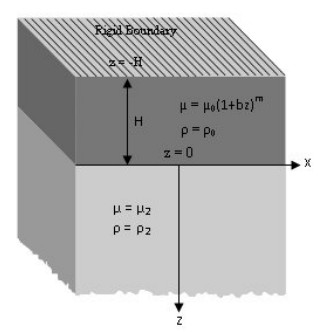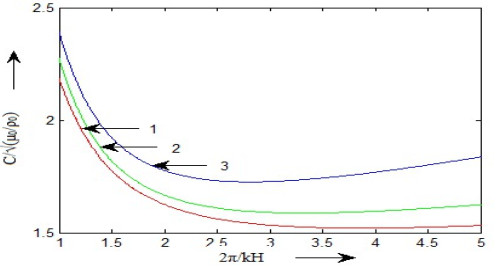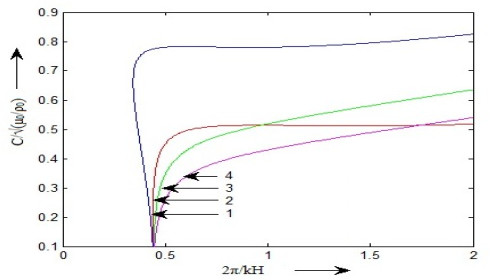1.
Introduction
The study of the propagation of Rayleigh waves in the layered non-homogeneous earth is central interested in theoretical seismologists. As a result of intensive studies of many authors, a good amount of information about the propagation of Rayleigh waves with different variations in density and rigidity is available. A book of Ewing, Jardetzky and Press (1957) [1], Achenbach (1973) [2], Miklowitz (1978) [3], Pilant (1979) [4] and many other different books contains a vast amount of information on the propagation of Rayleigh waves. After these books were published, many publications on these topics are available in different journals. Wang et al. (2008) [5] studied the propagation and localization of Rayleigh waves in disordered piezoelectric phononic-crystals. Liu and Liu (2004) [6] studied the propagation characteristics of Rayleigh waves in orthotropic fluid-saturated porous media. Abd-All et al. (2011) [7] studied the propagation of Rayleigh waves in generalized magneto-thermo-elastic orthotropic material under initial stress and gravity field. Rayleigh wave propagation in layered heterogeneous media has been studied in detail by Wilson (1942) [8], Biot (1965) [9], Newlands (1950) [10] and Stonely (1934) [11]. Dutta (1963) [12] illustrated Rayleigh wave propagation in a two-layer anisotropic media whereas propagation of Rayleigh wave in an elastic half-space of orthotropic and viscoelastic material has been discussed by Abd-Alla (1999) [13] and Abd-Alla (2015) [14]. Sharma and Mohinder (2004) [15] studied Rayleigh-lamb waves in the magneto-thermo-elastic homogeneous isotropic plate. Mitra (1957) [16] studied Rayleigh waves in multi-layered media. In some of the studies reported their solution is expressed in Whittaker function (1990) [17] and the computation is involved with the asymptotic expansion of the function. The effects of tidal waves are studied by different authors such as Z. Hu et al. (2015, 2015, 2017) [18,19,20], Chen et al. (2018) [21] and Suzuki et al. (2019) [22]. The expansion is valid on larger depth but does not give good result in shallow depth. Newlands (1950) [10] found a new approach to the problem and obtained a solution that may be used in shallow depth. Following Newlands, in this paper attempt has been made to study the effect of rigid boundary on the propagation of Rayleigh wave in an incompressible heterogeneous medium over an incompressible half-space. The non-homogeneity has been taken in variation in the rigidity.
In this paper, the author dealt with the effect of the rigid boundary of propagation on Rayleigh waves in an incompressible heterogeneous layer over an initially stressed incompressible half-space. The heterogeneity has been taken in rigidity as and density as and in the upper layer. The equation of the upper layer has been solved by the Newlands method (1950).
2.
Formulation of the problem
Suppose an incompressible medium of thickness H under rigid layer with shear modulus rigidity μ=μ0(1+bz)m and density ρ=ρ0 lying over another incompressible half-space with constant shear modulus μ2 and density ρ2, being taken as the vertical distance from the origin at the interface of an incompressible medium and incompressible half-space whereas the rigid surface exits at z=−H. The downward direction of z has been taken as positive in Figure 1.
Consider the wave propagating along x-axis with wave velocity C and wave-length 2πk. Let u and w are the displacement component in the x- and z- direction respectively at the point (x, y, z) at any time. Suppose that apart from a factor eik(x−Ct) and u, w are functions of z only.
3.
Equation of motion and solution
3.1. Equation of motion and solution for upper layer
The equation of motion in two diminutions for an elastic solid are
where, since the medium is incompressible,
Substituting,
where ϕ and ψ being scalar and vector potentials, by μ=μ0(1+bz)m, incompressibility condition Δ=0, together with limλ→∞,Δ→0λΔ→P1, whereP1 the hydrostatic stress, Eq (1) takes the form as Again, substituting,
which are satisfied by
From Eq (5)
Taking Z=(1+bz) in Eq (6), we have
In power of (kb)2, the series solution of Eq (7), may be written as
Hence,
Thus, if
Since the series [Eq (9)] converges and involves with two constants, then it is a valid solution. We have,
Due to linearity of Eq (7), we have
Where,
Now,
And the solution of ψ(1) and ψ(2) are readily obtained as follows:
Case Ⅰ : When m = 1
The solutions are
Case Ⅱ: when m = 2
The solution are
Case Ⅲ: when m = 3
The solution are
Case Ⅳ: when any value of m except 1, 2 and 3
The solutions are
Hence the final solutions are
Hence the displacement and stress component along x- and z- direction in the incompressible layer sandwiched between the rigid surface and a half-space are given by
where, ε=C2ρμ0
3.2. Solution for the homogeneous half-space
The values of ϕ and ψ as
Where, n=(1−ρ2C2μ2)
Hence the displacement and stress component along x- and z- direction in the incompressible layer sandwiched between the rigid surface and a half space are given by
where, δ=ρ2ρ0
3.3. Boundary conditions and dispersion relation
From the Figure 1 we can use the following boundary conditions:
(ⅰ) At z=0, the displacements are continuous
u1=u2
w1=w2
(ⅱ) At the interface z = 0, the continuity of the stress requires that
(σxz)1=(σxz)2
(σzz)1=(σzz)2
(ⅲ) At z = -H, the displacement vanishes
u1=0
w1=0
By using the boundary condition (ⅰ) and (ⅱ), we have
By using the boundary condition (ⅲ), we have
From the Eqs (29) and (30), we have the relation between Q1,Q2,A1 and A2
where
The consistency of Eq (30) for non-trivial solution of R and S implies that,
Equation (36) is the required equation for the dispersion of Rayleigh surface wave in an incompressible heterogeneous layer lying over an incompressible homogeneous elastic half-space under rigid layer.
4.
Numerical results and discussion of the result
On the above study the authors are used to parametric relation are taken as bH=0.5,ρ2ρ0=1.2,μ2μ0=1.8., respectively as given in Table 1. For equation, the dispersion curve of Rayleigh waves has been calculated in Eq (35) for different values of m starting from 0 to 5 and the authors observed that the nature of phase velocity for different values of 2πkH in an incompressible heterogeneous under rigid layer. The results are presented in Figures 2 and 3. In Figure 2 for different values of m = 1, 2 and 3 respectively being shows that in the assumed medium under a rigid layer, Rayleigh wave velocity decreases with increases of 2πkH.We also observed that in case of linear, quadratic and cubic variation of rigidity in an incompressible heterogeneous under rigid layer as the phase velocity of Rayleigh waves increases as rigidity increases. On the other hand in case in case of the phase velocity of Rayleigh waves increases as 2πkH increases under rigid layer. In case the homogeneous incompressible elastic medium under rigid layer the phase velocity of Rayleigh waves more compares to m = 0, 0.5, 4 and 5.
5.
Conclusions
From the above study, the authors reveals that some of the important facts regarding the propagation of Rayleigh waves in assumed medium and half-space under rigid layer as
(ⅰ)The phase velocity of Rayleigh waves in an assumed medium under rigid layer decreases in the linear, quadratic and cubic variation of rigidity only.
(ⅱ)The phase velocity of Rayleigh waves increases for different values of m = 0, 0.5, 4 and 5.
(ⅲ)The phase velocity of Rayleigh waves in an assumed medium under a rigid layer decreases only m = 1, 2 and 3 otherwise increases.
Acknowledgements
The authors are sincerely thankful to the Asansol Engineering College, IIT(ISM), Dhanbad and Brainware Group of Institutions for their all kind of support. The authors are also thankful to the reviewer for their guidance to improve the work.
Conflict of interest
The authors declare no conflict of interest in this paper.










 DownLoad:
DownLoad:



















